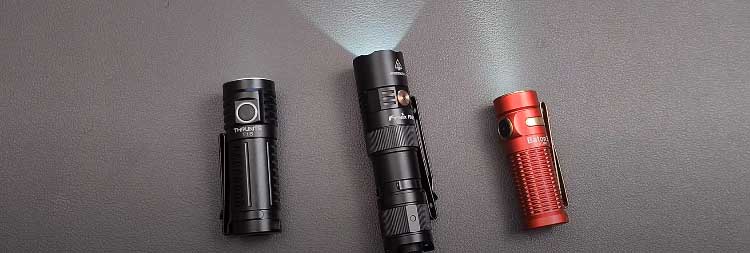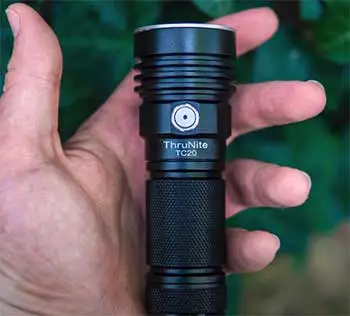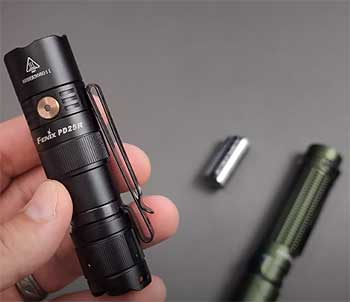If you’re in the market for a new flashlight, you’ve probably come across Thrunite and Fenix as two of the top options. Both companies make high-quality, durable flashlights with impressive performance.
But which brand reigns supreme? I’ve tested out numerous models from both Thrunite and Fenix, so let me break down the key differences and help you decide which is better for your needs.
A Brief Comparison Table
| Feature | Thrunite | Fenix |
| Price Range | $20-$100 | $50-$200+ |
| Build Quality | Very good for the price | Excellent, aircraft-grade aluminum |
| Light Output | Up to 3500 lumens | Up to 3200 lumens |
| Beam Distance | 150-650 yards | 200-656+ yards |
| Durability | IPX-8 waterproof, 6.5 foot drop test | IP68 waterproof, 10 foot drop test |
| Warranty | 5 years | Lifetime warranty |
| Modes | Lots of options – firefly, strobe, SOS, etc. | Straightforward, focus on 3-6 main levels |
| Power Management | Good, slight dimming at lower battery | Excellent regulation, maintains full brightness |
| Specialty Models | Dive, weapon, photography | Headlamps, weapon, bike, lanterns |
| General Use | Better value for EDC and household use | Better for demanding outdoor/tactical use |
Overview of Thrunite and Fenix
First, let’s get an overview of each brand.

Thrunite is a relatively new player in the flashlight world, founded in 2010.
But despite their newcomer status, they’ve made quite a name for themselves in a short time by focusing on value.
Thrunite aims to provide feature-packed flashlights at more budget-friendly prices compared to older brands like Fenix.
Most of their flashlights fall in the $20-$100 range.
Fenix has been around longer, since 2001.
They’re renowned for high-end Cree LED flashlights known for exceptional build quality, brightness, range, and reliability.
Their products skew towards the premium end, usually $50 on up to $200+ for their high-output options designed for search and rescue and other demanding applications.
So in a nutshell:
- Thrunite is focused on value, offering more affordable but well-built options.
- Fenix emphasizes premium performance and durability, but at higher prices.
Next, let’s explore some key factors in-depth.
Key Differences Between Thrunite And Fenix Flashlights

- Build Quality and Durability
Flashlights need to stand up to plenty of wear and tear. Overall, Fenix edges out Thrunite when it comes to build quality and durability.
Fenix utilizes aircraft-grade aluminum bodies with anti-abrasive finishes.
Most of their flashlights meet IP68 ratings for dustproofing and water resistance up to 2 meters submersion.
They perform extensive drop, impact, and environment testing. This ruggedness does come at a price premium.
Thrunite doesn’t quite match that level of resilience. But their build quality is still impressive for the price.
Most Thrunite models use durable aluminum too, with finishes like HAIII military-grade hard anodizing.
IPX-8 water resistance up to 2 meters is common. I wouldn’t call them bomb-proof like some Fenix models, but they can certainly handle outdoor use.
For demanding conditions like camping, law enforcement, and rescue applications, Fenix is worth the investment. For everyday carry and household use, Thrunite provides pretty solid durability at a more wallet-friendly cost.
- Light Output and Beam Performance
The most important factors for any flashlight are brightness, beam distance, and quality. Fenix and Thrunite both utilize Cree LEDs known for excellent output. But Fenix tends to use higher-performing emitters and optics.
For example, Fenix’s LD30RFP flagship runs on a Cree XHP35 HI LED pumping out a massive 3200 lumens on turbo. It throws 656 yards on a focused beam. Thrunite’s TN36 Limited tops out at 3500 lumens but only throws 588 yards. Fenix consistently outdoes Thrunite for intensity, distance, andoptimized reflectors.
That said, most everyday users don’t need ultra-long throw and eye-searing output. Even Thrunite’s budget options like the Archer 1A provide plenty of brightness and range for typical use. Plus Thrunite offers ramping and firefly modes that Fenix lacks on some models.
If sheer power is essential, Fenix dominates. But Thrunite covers most lighting needs admirably at a lower entry cost.
- Features and User-Friendliness
When it comes to features, it’s a split decision. Thrunite packs in more modes and extras, especially at lower prices. Even budget Thrunite models under $30 offer 6+ output levels, firefly and strobe, battery level indicators, and shortcuts to special modes. Mid-range and higher-end Thrunite’s add extras like:
- Ramping brightness
- Momentary activation
- Tactical strobe
- Battery voltage displays
- Integrated charging and power banks
Fenix sticks to more straightforward feature sets focused on ruggedness and ease of use. Most Fenix lights have 3-6 main output levels without ramping or firefly. Some favorites like the LD22 have shortcuts from off to low or turbo. But you won’t see as many bells and whistles.
For those wanting lots of customization and modes, Thrunite is ideal. If you just need a simple, robust light, Fenix fits the bill.
- Power and Battery Life

Advanced power management is key for any LED flashlight.
Efficient drivers and circuitry optimize brightness while maximizing battery runtime.
In this arena, Fenix again has a slight edge.
Thanks to excellent voltage regulation, most Fenix flashlights maintain consistent output throughout the battery life.
As the battery drains, the light doesn’t start dimming until the last 5-10 minutes.
With Thrunite, you tend to see more gradual dimming starting around 50-75% of the battery capacity. Not a dealbreaker, but Fenix better maintains full brightness for longer.
For battery compatibility, both brands can run either button-top or flat-top cells without issue. Fenix produces their own branded batteries designed for high-drain devices. But standard Eneloops or lithium cells work fine. Thrunite includes their branded battery with many flashlights. Third-party options work as well.
If you want peak power efficiency, Fenix has a small advantage. But Thrunite puts up impressive performance too.
- Price and Value
Here’s where Thrunite reigns supreme. Dollar for dollar, Thrunite provides excellent performance and features at very wallet-friendly pricing. Models like the Archer 1A cost less than $30 yet still offer 500+ lumen output, over 200 yards of throw, and 6 modes.
Even Thrunite’s top-shelf TC20 averages just $60-70 and competes with Fenix models costing $100+.
With Fenix, you certainly pay a premium. But what you get is exceptional quality, maxed-out output, and outstanding durability. For budget buyers, Thrunite gives you 90% of Fenix quality at 50% of the price. Thus, Thrunite provides better overall value hands-down.
- Reliability and Warranty

When you depend on a flashlight for emergencies or work use, longevity and reliability are critical.
Here Fenix pulls ahead of Thrunite again.
From what I’ve seen, Fenix lights have a bit longer lifespan and lower failure rate overall.
With IP68-rated ruggedness and advanced thermal design, they withstand heat and abuse that would shorten cheaper lights.
Plenty of users report Fenix models working 5, 10+ years later.
Thrunite flashlights aren’t unreliable by any means. But I’ve seen more reports of issues like flickering, electronics failures, or switch malfunctions after a few years. Thrunite’s budget pricing requires some cost cutting that affects longevity.
Fenix provides a “no hassle” lifetime warranty against defects. Thrunite has a more limited 5 year warranty. Overall, Fenix takes reliability and warranty support more seriously.
Niche Models and Unique Options
Beyond standard handheld flashlights, both companies offer niche specialty lights:
- Thrunite: Dive lights, angler lights, photography lights, weapon lights
- Fenix: Helmet lights, headlamps, weapon lights, bike lights, lanterns
Fenix has a leg up with more models designed specifically for activities like camping, biking, or law enforcement use. For a brand catering to budget buyers, Thrunite still has an impressively diverse product line. But they can’t match the sheer range of specialty and enthusiast models Fenix offers.
If you need a flashlight precisely tailored for a certain application, Fenix is ahead. Thrunite covers the basics well with some unique options.
Also Read: Comparison of Streamlight And Fenix Flashlights.
Frequently Asked Questions (FAQ)
For pure maximum performance, not many can beat Fenix. Some competitors like Olight, Acebeam and Manker can match or exceed Fenix for output and beam distance. But Fenix remains a top-tier premium brand when it comes to no-compromise quality and durability. More budget-friendly brands can’t match Fenix builds.
Absolutely. Fenix makes some of the best high-performance LED flashlights on the market. They’ve built a reputation for unmatched quality, reliability, and power. Law enforcement, military, rescue teams, and enthusiast users praise the durability of Fenix lights. If you want the very best without compromise, Fenix is easily a top 3 brand.
Some of Fenix’s biggest competitors include:
1. Olight – Known for patented beam shaping technology and rechargeable models. Similar premium quality at high prices.
2. Acebeam – Emphasis on extreme brightness and battery efficiency. Popular with enthusiast flashlight nerds.
3. Streamlight – Top brand among law enforcement and first responders. Reliable and durable.
4. Nitecore – Wide range from budget to high-performance. Innovative designs and features.
5. SureFire – Legendary USA-made tactical flashlight company. The gold standard for many.
While less known by the general public than SureFire or Streamlight, Fenix matches or beats most competitors when it comes to advanced LED technology and durability.
Yes, Fenix lights are designed and manufactured in China, which helps keep costs lower compared to American brands. However, don’t let that fool you. Fenix factories follow extremely stringent quality control. And they are renowned for outstanding customer service and warranties which rival many US companies. Just because something is made in China doesn’t automatically mean poor quality. And Fenix proves that Chinese factories can produce products that outshine comparably priced American options.
Closing Remarks
So which brand is better for you? Here are some quick recommendations:
- For premium performance and bombproof durability, choose Fenix
- For budget buyers and general EDC use, Thrunite offers better value
- If you need advanced specialty models, Fenix has greater range
- For basic use on a budget, Thrunite exceeds expectations
I’d recommend Fenix for serious outdoor use, law enforcement, rescue, and other demanding applications where performance and ruggedness justify the price premium.
For budget shoppers, household and everyday carry use, Thrunite punches far above its class for the money. Thrunite also works well for hobbyists wanting lots of geeky extras.
Overall, while Fenix takes the crown for output and durability, most average users are better off pocketing the savings and going with Thrunite. You still get impressive Cree-powered lights with surprising quality given the affordable pricing.
Unless runtime and sheer output are paramount, Thrunite gives you 90% of Fenix pedigree at 50% the price.

